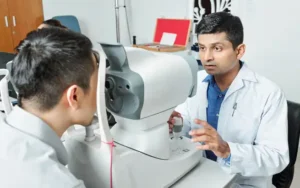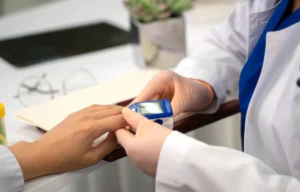Anyone with diabetes needs to learn about the Diabetic Retinopathy stages. It happens when high blood sugar hurts the tiny blood vessels in the back of the eye. This can lead to lots of vision troubles. The condition develops gradually usually without symptoms at first. There are four main stages that each cause changes to the back of the eye and different risks to sight.
In this article, you will understand these stages and how important it is to get regular eye checkups and more. At CCD (collaborative care of Diabetes) regular eye exams can catch any problems early so they don’t get too bad. Taking care of your eyes is key if you have the ‘sugar’ disease.
What Is a Diabetic Retinopathy?
A condition that can damage the tiny blood vessels in the eye’s retina. Our eyes allow us to see the beautiful world around us. But for people with diabetes mellitus, their vision may become threatened. However high sugar in the blood can hurt these small vessels. When this happens over time, it’s called diabetic retinopathy.
Fluid may leak or blood may seep where it isn’t supposed to. Fragile new vessels may form too, which isn’t good. If not treated, vision can get bad or you may not be able to see at all.
This condition occurs because diabetes can injure blood vessels all over the body, including in the precious eyes. The longer you have diabetes, especially if your sugar levels are often high, the more likely it is to affect your sight.
At first, you may not notice anything wrong with how you see. But later pictures may look blurred or you could have trouble seeing hues. In severe cases, much of the sight could fade away.
That’s why taking care of diabetes and having your eyes checked regularly by a doctor is so important. They can catch any changes early before vision is severely threatened.
4 Stages of Diabetic Retinopathy

Our eyes allow us to see the world, but diabetic retinopathy can threaten vision. This condition happens in four main stages, from mild changes to very serious damage. It’s important to understand each stage so you can work with your doctor to save your sight.
Mild Nonproliferative Diabetic Retinopathy
In the earliest stage, tiny bulges may form in the tiny blood vessels in the retina. These bulges can leak a little fluid, but vision is usually still clear.
Most people feel fine, so regular eye checks are key to catching it early. Monitoring is important even though treatment may not be needed yet.
Moderate Nonproliferative Diabetic Retinopathy
As it worsens to the next stage, more swelling and leaking occur in the delicate vessels. You may start to see some changes like blurred or hard-to-focus vision. Frequent checkups are important now since problems are more likely.
Severe Nonproliferative Diabetic Retinopathy
The condition grows very serious in the third stage. Many vessels are blocked, cutting off blood flow and oxygen to the retina. This makes new vessels try to grow but they tend to leak.
You could see dark spots or blobs in your sight. It’s essential to get medical help now before issues get bigger.
Proliferative Diabetic Retinopathy
In the final stage, abnormal new vessels grow and can burst blood into the eye. This blood causes major vision issues like very blurred sight and partial or total blindness.
Immediate medical care is crucial to manage it and save what vision remains. Regular eye exams and prompt treatment are vital to minimize the risk of permanent damage. Taking care of your diabetes also helps slow the progression.
How Does CCD Help in Managing Diabetic Retinopathy?

The Collaborative Care for Diabetes Institute works hard to help people manage their eye condition from sugar. Their team focuses on regular checkups, learning, and support for diabetic patients. By working with doctors, nurses, and eye experts, they help patients understand their problems and why eye health is so important.
During checkups, the CCD center can find early signs of eye trouble, so treatment can start fast. We also teach how to control blood sugar levels, which is key to stopping eye issues. Plus, the institute offers resources and encouragement to make healthier choices like diet and exercise.
Overall, the CCD center is dedicated to improving health and happiness for those with diabetes. We make sure people get the care needed to protect their sight and keep their quality of life high. Working together, the team and patients can catch eye changes early before vision is threatened. With learning and support, patients can better manage their sugar to save their precious ability to see!
Conclusion
It’s really important to know about the different stages of diabetic retinopathy and how it affects the eyes over time. We talked about how there are four main stages, each with its signs and dangers. From small changes in the tiny blood vessels to really bad damage that can cause vision loss, recognizing these stages helps people take good care of their eye health.
Getting regular eye checkups and controlling blood sugar are key to stopping the condition from getting worse. By staying up-to-date on this important info with CCD and partnering closely with doctors, those with diabetes can protect their sight and keep living life to the fullest.
FAQ’s
What are the stages of diabetic retinopathy?
There are four stages: mild, moderate, severe nonproliferative, and proliferative. Each one affects vision differently as it gets worse.
How can I prevent it?
You can stop it from happening by keeping tight control of your blood sugar, getting your eyes checked regularly, and doing what your doctor says.
How does CCD help manage it?
The CCD center does regular checkups so issues don’t sneak up on you. They also provide lots of learning and encouragement to help people handle their diabetes.












